New York City Police Department
| City of New York Police Department | |
|---|---|
 | |
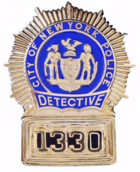 Badge of an NYPD detective | |
 | |
| Common name | New York City Police Department |
| Abbreviation | NYPD or NYCPD |
| Motto | Fidelis ad mortem (Template:Lang-en) |
| Agency overview | |
| Formed | 1845 |
| Employees | 49,526 (2013)[1] |
| Annual budget | $4.8 billion |
| Jurisdictional structure | |
| Operations jurisdiction | New York, U.S. |
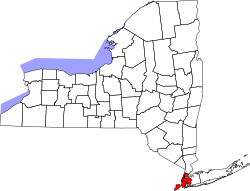 | |
| Map of City of New York Police Department's jurisdiction | |
| Size | 468.9 square miles (1,214 km2) |
| Population | 8,550,405[2] |
| Legal jurisdiction | New York City |
| General nature | |
| Operational structure | |
| Headquarters | 1 Police Plaza Park Row Lower Manhattan across the street from City Hall |
| Police Commissioner responsible | |
| Agency executive |
|
| Parent agency | City Administrator's Office |
| Units | List
|
| Boroughs | List
|
| Facilities | |
| Commands | 77 Precincts 12 Transit Districts 9 Housing Police Service Areas |
| Police cars | 8,839 |
| Police boats | 11 |
| Helicopters | 8 |
| Horses | 120 |
| Dogs | 31 German Shepherds 3 Bloodhounds |
| Website | |
| www.NYC.gov | |
The New York City Police Department (NYPD or NYCPD), officially the City of New York Police Department, is the largest municipal police force in the United States.[5] Established in 1845, the agency has primary responsibilities in law enforcement and investigation within the five boroughs of New York City. The NYPD is one of the oldest police departments established in the U.S., tracing its roots back to the seventeenth century.
The NYPD has a broad array of specialized services, including the Emergency Service Unit, K9, harbor patrol, air support, bomb disposal, counter-terrorism, criminal intelligence, anti-gang, anti-organized crime, narcotics, public transportation and public housing; the New York City Transit Police and New York City Housing Authority Police Department were fully integrated into the NYPD in 1995. According to the department, its mission is to "enforce the laws, preserve the peace, reduce fear, and provide for a safe environment." The department's regulations are compiled in title 38 of the New York City Rules.
In June 2004, there were about 40,000 sworn officers plus several thousand civilian employees; in June 2005, the number of officers dropped to 35,000. As of December 2011, that figure increased slightly to over 36,600, helped by the graduation of a class of 1,500 from the New York City Police Academy. The NYPD's current authorized uniformed strength is 34,450.[6] There are also approximately 4,500 Auxiliary Police Officers, 5,000 School Safety Agents, 2,300 Traffic Enforcement Agents, and 370 Traffic Enforcement Supervisors currently employed by the department. The Patrolmen's Benevolent Association of the City of New York (NYC PBA), the largest municipal police union in the United States, represents over 50,000 active and retired NYC police officers.
The NYPD Intelligence Division & Counter-Terrorism Bureau has officers stationed in 11 cities internationally.[7][8] In the 1990s the department developed a CompStat system of management which has also since been established in other cities.
The NYPD is headquartered at 1 Police Plaza, located on Park Row in Lower Manhattan across the street from City Hall.[9]
NYPD has extensive crime scene investigation and laboratory resources, as well as units which assist with computer crime investigations. The NYPD runs a "Real Time Crime Center", essentially a large search engine and data warehouse operated by detectives to assist officers in the field with their investigations.[10] A Domain Awareness System, a joint project of Microsoft and NYPD, links 6,000 closed-circuit television cameras, license plate readers, and other surveillance devices into an integrated system.[11]
Due to its high-profile location in the largest city and media center in the United States, fictionalized versions of the NYPD and its officers have frequently been portrayed in novels, radio, television, motion pictures and video games.
Etymology
Members of the NYPD are frequently referred to by politicians, some media and their own police cars by the nickname New York's Finest.
History
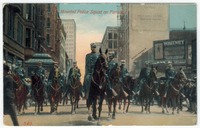
The Municipal Police were established in 1845, replacing an old night watch system. In 1857, it was tumultuously replaced by a Metropolitan force, which consolidated many other local police departments in 1898. Twentieth-century trends included professionalization and struggles against corruption.
Rank structure
Officers begin service with the rank of Probationary Police Officer, also referred to as Recruit Officer. After successful completion of six months of Police Academy training and various academic, physical, and tactical tests, officers graduate from the Police Academy. While officially retaining the title of Probationary Police Officer, graduates are referred to as a Police Officer, or informally as a "Rookie", until they have completed an additional 18 months probationary period.
There are three career "tracks" in the NYPD: supervisory, investigative, and specialist. The supervisory track consists of 12 sworn titles, referred to as ranks. Promotion to the ranks of sergeant, lieutenant and captain are made via competitive civil service examinations. Promotion to the ranks of deputy inspector, inspector, deputy chief, assistant chief and chief are made at the discretion of the police commissioner, after successfully passing a series of civil service exams. Promotion from the rank of police officer to detective is determined by the current police labor contract, with the approval of the commissioner. The entry level appointment to detective is third grade or specialist. The commissioner may grant discretionary grades of first or second. These grades offer compensation roughly equivalent to that of supervisors. Specifically, a second grade detective's pay roughly corresponds to a sergeant's and a first grade detective's pay roughly corresponds to a lieutenant's. Detectives are police officers who have been given a more investigatory position but no official supervisory authority. A Detective First Grade still falls under the command of a sergeant or above. Just like detectives, sergeants and lieutenants can receive pay grade increases within their respective ranks.
| Title | Insignia | Badge design | Badge color | Badge number | Uniform |
|---|---|---|---|---|---|
| Chief of Department | Medallion with eagle and stars | Gold, with silver stars | No | White shirt, black peaked cap, gold hat badge | |
| Bureau Chief Supervising Chief Surgeon |
|||||
| Assistant Chief Assistant Chief Chaplain † Assistant Chief Surgeon |
|||||
| Deputy Chief Deputy Chief Chaplain † District Surgeon |
Medallion with eagle and star | ||||
| Inspector Chaplain † Police Surgeon |
Medallion with eagle | Gold | |||
| Deputy Inspector | Laurels and crown with oak leaves | ||||
| Captain | Laurels and crown | ||||
| Lieutenant | Medallion | ||||
| Sergeant | Shield with eagle | Yes | Navy blue shirt, peaked cap, gold hat badge | ||
| Detective (grades 3rd–1st) | None | Medallion | |||
| Police officer | Shield | Silver | Yes, matching hat badge |
Navy blue shirt, peaked cap, silver hat badge with matching number | |
| Probationary Police officer | |||||
| Recruit officer | Yes | Slate grey, black garrison cap | |||
| Cadet | None | ||||
^ †: Uniform rank that has no police powers


There are two basic types of detective in the NYPD: detective-investigators and detective-specialists.
Detective-Investigators are the type most people associate with the term "detective" and are the ones most frequently portrayed on television and in the movies. Most police officers gain their detective title by working in the Narcotics Division of the Organized Crime Control Bureau and are then moved to the Detective Bureau. Detectives assigned to squads are co-located within each precinct and are responsible for investigating murders, rapes, robberies, burglaries and other crimes within that precinct's boundaries. Other detective-investigators are assigned to specialized units at either the major command or citywide level, investigating terrorist groups, organized crime, narcotics dealing, extortion, bias crimes, political corruption, kidnappings, major frauds or thefts committed against banks or museums, police corruption, contractor fraud and other complex, politically sensitive or high-profile cases. A squad of detective-investigators is also assigned to each of the city's five district attorneys' offices. (Arsons are investigated by The Arson and Explosion Squad as well as fire marshals, who are part of the New York City Fire Department.)
Promotion from Police Officer to Detective-Investigator is based on investigative experience. Typically, a Police Officer who is assigned to investigative work for 18 months will be designated "Detective-Investigator" and receive the gold shield and pay increase commensurate with that designation. In the recent past, however, there has been controversy over the budget-conscious department compelling police officers to work past the 18 months without receiving the new title.
Newly appointed detectives start at Detective Third Grade, which has a pay rate roughly between that of Police Officer and Sergeant. As they gain seniority and experience, they can be "promoted" to Detective Second-Grade, which has a pay grade slightly less than sergeants. Detective First-Grade is an elite designation for the department's most senior and experienced investigators and carries a pay grade slightly less than Lieutenants. All these promotions are discretionary on the part of the Commissioner and can be revoked if warranted. And while senior detectives can give directions to junior detectives in their own squads, not even the most senior detective can lawfully issue orders to even a junior patrol officer. All Detective grades still fall under the "chain of command" of the supervisory ranks beginning with Sergeant through Chief of Department. Detectives, like Police Officers, are eligible to take the promotional civil service exams for entry into the supervisory ranks.
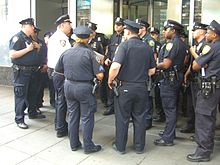
While carrying with them increased pay and prestige, none of these Detective grades confer on the holder any supervisory authority. Contrary to some media portrayals, there is no specific rank of "Detective Sergeant" or "Detective Lieutenant". Lieutenants and Sergeants are assigned to oversee Detective squads as Supervisors, and are responsible for all investigations.
There is a small percentage of Lieutenants and Sergeants who work as Investigative Supervisors (approximately equal to 10% of their respective ranks) and are granted the prestigious pay grade designations of "Sergeant—Supervisor Detective Squad" (SDS), or Lieutenant—Commander Detective Squad (CDS) therefore assuming full Investigative command responsibility as opposed to operational supervision. Their pay grade rises to an approximate midpoint between their normal rank and the next highest rank's pay grade, and similar to a Detective's "grade", is also a discretionary promotion. This pay grade designation is achieved by assignment to Investigative units, i.e. Detective Bureau, Internal Affairs Bureau, Counter-Terrorism Bureau, Intelligence Bureau, and Organized Crime Control Bureau. Lieutenants and Sergeants in non-investigatory assignments can be designated Lieutenant-Special Assignment or Sergeant-Special Assignment, pay equivalent to their investigative counterparts.
"Detective-specialists" are a relatively new designation and one unique to the NYPD. In the 1980s, many detectives resented that some officers were being granted the rank of detective in order to give them increased pay and status, but were not being assigned to investigative duties. Examples included officers assigned as bodyguards and drivers to the mayor, police commissioner and other senior officials.
To remedy this situation, the rank of detective-specialist was created. These officers are typically found in specialized units because they possess a unique or esoteric skill the department needs, e.g., crime-scene tech, sharpshooter, bomb technician, scuba instructor, helicopter instructor, sketch artist, etc. Like detective-investigators, detective-specialists start at third-grade and can be promoted to second- or first-grade status.

The Department is administered and governed by the Police Commissioner, who is appointed by the Mayor. Technically, the commissioner serves a five-year term; as a practical matter, the commissioner serves at the Mayor's pleasure. The commissioner in turn appoints numerous deputy commissioners. The commissioner and his subordinate deputies are civilians under an oath of office and are not uniformed members of the force who are sworn officers of the law. However, a police commissioner who comes up from the uniformed ranks retains that status while serving as police commissioner. This has ramifications for their police pensions and the fact that any police commissioner who is considered sworn does not need a pistol permit to carry a firearm, and does retain the statutory powers of a police officer. Some police commissioners (like Ray Kelly) do carry a personal firearm, but they also have a full-time security detail from the Police Commissioner's (Detective) Squad.
A First Deputy Police Commissioner may have a security detail when he/she acts as commissioner or under other circumstances as approved by the police commissioner.
Commissioner titles:
| Title | Insignia |
|---|---|
| Police Commissioner | |
| First Deputy Commissioner | |
| Deputy Commissioner |
These individuals are administrators who supersede the Chief of Department, and they usually specialize in areas of great importance to the Department, such as counterterrorism, operations, training, public information, legal matters, intelligence, and information technology. Despite their role, as civilian administrators of the Department, deputy commissioners are prohibited from taking operational control of a police situation (the Commissioner and the First Deputy Commissioner may take control of these situations, however). They still want to continue with the stop and frisk act.
Within the rank structure, there are also designations, known as "grades", that connote differences in duties, experience, and pay. However, supervisory functions are generally reserved for the rank of sergeant and above.
Badges in the New York City Police Department are referred to as "shields" (the traditional term), though not all badge designs are strictly shield-shaped. Every rank has a different badge design (with the exception of Police Officer and Probationary Police Officer), and upon change in rank officers receive a new badge. Lower-ranked police officers are identified by their shield numbers, and tax registry number. Lieutenants and above do not have shield numbers and are identified by tax registry number. All sworn members of the NYPD have their ID card photos taken against a red background. Civilian employees of the NYPD have their ID card photos taken against a blue background, signifying that they are not commissioned to carry a firearm. All ID cards have an expiration date.
Medals
The NYPD presents medals to its members for meritorious service.
Organization and structure

Office of the Chief of Department
The Chief of Department serves as the senior sworn member of the NYPD.[12] Carlos M. Gomez is the 39th individual to hold the post, which prior to 1973 was known as the Chief of Operations and before that as Chief Inspector.[13]
Bureaus
The Department is divided into ten bureaus, six of which are enforcement bureaus. Each enforcement bureau is sub-divided into sections, divisions, and units, and into patrol boroughs, precincts, and detective squads. Each Bureau is commanded by a Bureau Chief (such as the Chief of Patrol and the Chief of Housing). There are also a number of specialized units (such as the Operations Unit and Compstat) that are not part of any of the Bureaus and report to the Chief of the Department.
Personnel

Crime prevention
Domain Awareness System
In August 2008, the Lower Manhattan Security Initiative in a partnership between the New York City Police Department and Microsoft began the Domain Awareness System to monitor New York City.[14] The program allowed the department to track surveillance targets and gain detailed information about them. The system is connected to 6,000[15] video cameras around New York City as well as check radiological and nuclear detectors onboard helicopters, trucks and boats as well as detectors on police officers' gun belts that were so sensitive that people who have had medical procedures may trigger them. Lower Manhattan now includes thousands of surveillance cameras that can identify shapes and sizes of unidentified "suspicious" packages and can track people within seconds using descriptions such as "someone wearing a red shirt". In 2009, an extension into Midtown Manhattan was announced[16] and by 2012 the program was fully implemented.
The system was also licensed out to other cities with New York City getting 30% of the profits.[17] The system's development costs were estimated at US$40 million.[18]
This system was highlighted in a May 2013 episode of PBS' Nova on tracking the Boston Marathon Bombers.[19]
Demographics
As of the end of 2010, 53% of the entire 34,526-member police force were white and 47% were members of minority groups. Of 22,199 officers on patrol, 53% (11,717) were black, Latino (of any race), or Asian or Asian-American, and 47% (10,482) were non-Hispanic white. Of 5,177 detectives, 57% (2,953) were white and 43% (2,224) were people of color. Of 4,639 sergeants, 61% (2,841) were white and 39% (1,798) were minorities. Of 1,742 lieutenants, 76% (1,323) were white and 24% (419) were people of color. Of 432 captains, 82% (356) were white and 18% (76) were minorities. Of 10 chiefs, 7 were white and 3 were people of color. In 2002, whites accounted for 60% of members in the rank of police officer. Between 2002 and 2010, the number of minorities in top-tier positions in the force increased by about 4.5%.[20]
Corruption and misconduct
The Civilian Complaint Review Board is an all-civilian, 13-member panel tasked with investigating misconduct or lesser abuse accusations against NYPD officers, including use of excessive force, abuse of authority, discourtesy and offensive language. Complaints against officers may be filed online, by US mail, by phone or in person at any NYPD station.[21]
Affiliations
The NYPD is affiliated with the New York City Police Foundation and the New York City Police Museum. It also runs a Youth Police academy to provide positive interaction with police officers and to educate young people about the challenges and responsibility of police work. The department also provides a citizen Police Academy which educates the public on basic law and policing procedures.
Line of duty deaths
According to the Officer Down Memorial Page, the NYPD has lost 841 officers in the line of duty since 1849, the most recent officer having been lost on November 4, 2016[update].[22] This figure includes officers from agencies that were absorbed by or became a part of the modern NYPD in addition to the modern department itself. This number also includes officers killed on and off duty by gunfire of other officers on duty. The NYPD lost 23 officers in the September 11, 2001 attacks, not including another 61 who died of illnesses related to the attacks.[22]
| Type | Number |
|---|---|
| 9/11-related illness | 84 |
| Accidental | 9 |
| Aircraft accident | 7 |
| Animal related | 18 |
| Assault | 33 |
| Automobile accident | 52 |
| Bicycle accident | 4 |
| Boating accident | 5 |
| Bomb | 2 |
| Drowned | 12 |
| Duty-related illness | 10 |
| Electrocuted | 5 |
| Explosion | 8 |
| Exposure to toxins | 3 |
| Fall | 10 |
| Fire | 16 |
| Gunfire | 325 |
| Gunfire (accidental) | 25 |
| Heart attack | 46 |
| Motorcycle accident | 36 |
| Stabbed | 21 |
| Struck by streetcar | 7 |
| Struck by train | 5 |
| Struck by vehicle | 38 |
| Structure collapse | 3 |
| Terrorist attack | 24 |
| Vehicle pursuit | 12 |
| Vehicular assault | 21 |
| Total | 841[22] |
Vehicles
| Patrol cars | |||||
|---|---|---|---|---|---|
| Ford Crown Victoria | United States (origin) Canada (manufacture) |

|
|||
| Ford Police Interceptor Sedan[23][24] | United States | 
|
|||
| Chevrolet Impala | United States (origin) Canada (manufacture) |

|
|||
| Ford Fusion Hybrid | United States | 
|
|||
| Nissan Altima | Japan (origin) United States (manufacture) |

|
|||
| Dodge Charger | United States (origin) Canada (manufacture) |

|
| ||
| Toyota Prius | Japan | 
|
| ||
| Chevrolet Volt | United States | 
|
| ||
| SUVs | |||||
| Chevrolet Tahoe/GMC Yukon | United States | ||||
| Ford Explorer Special Service Vehicle | United States | 
|
| ||
| Ford Escape Hybrid | United States | 
|
|
||
| Parking enforcement scooters | |||||
| Westward Go-4 Interceptor | Canada | 
|
|||
| Cushman | United States | 
|
|||
| Smart ForTwo | Germany | ||||
| Emergency Service Unit vehicles | |||||
| Lenco Peacekeeper | United States |
| |||
| Lenco BearCat | United States | 
|
| ||
| Modified Ford F-550 | United States | 
|
| ||
| Mack | United States | 
|
| ||
| Communications vans | |||||
| Chevrolet van | United States | 
|
|||

|
|
||||
| Police buses | |||||
| AmTran body on Navistar International chassis | United States | 
|
|||
| TMC/Nova Bus RTS | United States | 
|
|||
| Orion V Suburban | Canada (origin) United States (manufacture) |
||||
| Modified Blue Bird All American | United States | 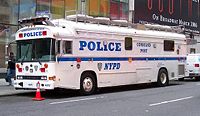
|
| ||
| Helicopters | |||||
| AgustaWestland AW119 | |||||
| Bell Helicopter Bell 412 | United States | ||||
| Miscellaneous | |||||
| Ford E-Series | United States | 
|
|||
| Modified Hummer H1 | United States |
| |||
| John Deere Gator | United States | 
|
|||
Vehicles also include police motorcycles.
Vehicle appearance
The current NYPD vehicle appearance is an all-white vehicle body with two blue stripes along each side of the car. The word "POLICE" is printed in small text above the front wheel wells, and as "NYPD Police" above the grille opening. The NYPD shoulder patch is printed on both sides just in front of the front doors or on the front doors. The letters "NYPD" are printed in blue Rockwell Extra Bold font on the front doors, and the NYPD motto "Courtesy, Professionalism, Respect" is printed on the rear doors. The unit's shop number is printed on the rear decklid. The shop number is also printed on the rear side panels above the gas intake, along with the number of the unit's assigned precinct.
Some Traffic Enforcement units used a modified paint job, with dark blue carbody and white stripes on the sides. The text on the car is also printed in white. These are being phased out in favor of units painted in a modified version of the regular NYPD paint job, with the word "TRAFFIC" printed on the rear side panels and trunk.
Some NYPD Auxiliary units used a modified paint job, with dark blue or black carbody and white stripes on the sides. The text on the car is also printed in white. These are being phased out in favor of units painted in a modified version of the regular NYPD paint job, with the word "Auxiliary" printed on the rear side panels and trunk.
Firearms
On duty
New NYPD officers are allowed to choose from one of three 9mm service pistols: the SIG Sauer P226 DAO, Glock 17/19, and Smith & Wesson 5946.[25][26] All are modified to a 12-pound (53 N) NY-2 trigger pull.[27] Officers who purchased revolvers prior to the transition to semi-automatic pistols on January 1, 1994, are "grandfathered" and if so can choose to continue to carry a revolver as a duty weapon.
Shotgun-certified officers were authorized to carry Ithaca 37 shotguns, which are being phased out by the newer Mossberg 590. Officers and detectives belonging to special investigative units, Organized Crime Control Bureau and NYPD's Emergency Service Unit[28] are armed with a range of select-fire weapons and long guns, such as the Colt M4A1 carbine and similar-pattern AR-15 rifles, Ruger Mini-14 rifle, Heckler & Koch MP5 submachine gun, and the Remington Model 700 bolt-action rifle.
Off duty
The firearms approved by the NYPD for off duty carry are the Glock 26, Smith & Wesson 3914 DAO, Smith & Wesson 3953TSW, Smith & Wesson Model 640 (.38 revolver), SIG Sauer P239 DAO, Springfield XDS, Smith & Wesson M&P Shield and the Beretta 8000D Mini Cougar. Along with those weapons, NYPD officers may also carry their authorized on duty firearms while off duty.[citation needed]
Discontinued from service
From 1926 until 1986 the standard weapons of the department were the Smith & Wesson Model 10 and the Colt Official Police .38 Special revolvers with four-inch barrels. Prior to 1994 the standard weapon of the NYPD was the Smith & Wesson Model 64 DAO (Double Action Only) .38 Special revolver with three or four inch barrels. This type of revolver was called the Model NY-1 by the department.
Prior to the issuing of the 9mm semi-automatic pistol NYPD Detectives and plain clothes officers often carried the Colt Detective Special and/or the Smith & Wesson Model 36 "Chief's Special" .38 Special caliber snub-nosed (2-inch) barrel revolvers for their easiness to conceal while dressed in civilian clothes.
The Kahr K9 9 mm pistol was an approved off-duty/backup weapon from 1998 to 2011. It was pulled from service because it could not be modified to a 12-pound NY-2 trigger pull.
In popular culture
See also
- Law enforcement in the United States
- Law enforcement in New York
- Law enforcement in New York City
- List of law enforcement agencies in New York
- Mary Shanley, 4th female detective
References
- ^ a b "FBI — Table 78". FBI.
- ^ "Annual Estimates of the Resident Population: April 1, 2010 to July 1, 2015 – 2015 Population Estimates – New York". United States Census Bureau. Retrieved March 24, 2016.
- ^ NYPD. "Commissioner James P. O'Neill". NYC.GOV. Retrieved 16 September 2016.
- ^ NYPD. "Chief of Department Carlos M.Gomez". NYC.GOV. Retrieved 16 September 2016.
- ^ "Bureau of Justice Statistics - Appendix table 1 - page 34" (PDF). Department of Justice. Retrieved December 5, 2013.
- ^ "NYPD - Frequently Asked Questions". Nyc.gov. Retrieved 2013-09-27.
- ^ "Document shows NYPD eyed Shiites based on religion". Associated Press - Ap.org. Retrieved 2013-09-27.
- ^ Hartmann, Margaret (2012-01-27). "NYPD Now Has an Israel Branch, New York Magazine". Nymag.com. Retrieved 2013-09-27.
- ^ "Property Clerk." New York City Police Department". Nyc.gov. 2011-02-16. Retrieved 2013-09-27.
- ^ From database to crime scene
- ^ NYPD launches new all-seeing 'Domestic Awareness System' Archived August 11, 2012, at the Wayback Machine RT News, 30 July 2012
- ^ "NYPD Administration". nyc.gov.
- ^ "NYPD - Administration". nyc.gov.
- ^ "News from the Blue Room". The City of New York. Office of the Mayor. 8 August 2012. Retrieved 6 April 2015.
- ^ "NYPD expands surveillance net to fight crime as well as terrorism". Reuters. June 21, 2013. Retrieved October 31, 2015.
- ^ ""Ring of Steel" Coming to Midtown". WNYC. 4 October 2009. Retrieved 6 April 2015.
- ^ Ungerleider, Neal (August 8, 2012). "NYPD, Microsoft Launch All-Seeing "Domain Awareness System" With Real-Time CCTV, License Plate Monitoring [Updated]". Fast Company. Retrieved 19 June 2013.
- ^ Long, Colleen (February 20, 2013). "NYPD, Microsoft Create Crime-Fighting 'Domain Awareness' Tech System". Associated Press. Archived from the original on February 24, 2013. Retrieved 19 June 2013.
{{cite news}}: Unknown parameter|deadurl=ignored (|url-status=suggested) (help) - ^ "Manhunt—Boston Bombers" (Video). NOVA. PBS. 29 May 2013. Retrieved 6 April 2015.
- ^ El-Ghobashy, Tamer (January 7, 2011). "Minorities Gain in NYPD Ranks". Wall Street Journal. Retrieved May 8, 2012.
- ^ "NYC Civilian Complaint Review Board". nyc.gov. nyc.gov. Retrieved 2015-03-28.
- ^ a b c "The Officer Down Memorial Page".
- ^ "Police Magazine". Policemag.com. Retrieved 2013-09-27.
- ^ The Ford Motor Company (2012-02-08). "Ford's All-New Police Interceptors Roll Off the Chicago Assembly Line, Purpose-Built to Protect and Serve | Ford Media Center". Media.ford.com. Retrieved 2013-09-27.
- ^ "Training Bureau | Firearms & Tactics Section". nyc.gov. Retrieved 2009-12-02.
- ^ http://www.nyc.gov/html/nypd/downloads/pdf/analysis_and_planning/nypd_annual_firearms_discharge_report_2014V3.pdf
- ^ Massad Ayoob (December 1999). "Trendy Guns Don't Sell Like The Classics". Shooting Industry.
- ^ "NYPD's Elite E-Men". Tactical Life. Retrieved 26 July 2014.
Further reading
- Darien, Andrew T. Becoming New York's Finest: Race, Gender, and the Integration of the NYPD, 1935-1980. (New York: Palgrave Macmillan, 2013)
- Miller, Wilbur R. Cops and bobbies: Police authority in New York and London, 1830-1870 (The Ohio State University Press, 1999)
- Monkkonen, Eric H. Police in Urban America, 1860-1920 (2004)
- Richardson, James F. "To Control the City: The New York Police in Historical Perspective." in Cities in American History, eds. Kenneth T. Jackson and Stanley K. Schultz (1972) pp: 3-13.
- Richardson, James F. The New York Police, Colonial Times to 1901 (Oxford University Press, 1970)
- Thale, Christopher. "The Informal World of Police Patrol: New York City in the Early Twentieth Century," Journal of Urban History (2007) 33#2 pp 183–216.
External links
- Official website
- Police Department in the Rules of the City of New York
- New York City Police Department collected news and commentary at The New York Times
- "Map of NYC Law Enforcement Line of Duty Deaths" (Map). Google Maps. Retrieved 2015-01-17.
- "With the Sky Police", Popular Mechanics, January 1932 article about the NY City Police Air Force and the Keystone-Loening Commuter in service at that time, photos pp. 26–30
- NYPD Annual Reports 1912–1923 (digitized books) from the Lloyd Sealy Library on the Internet Archive
- Historical images from the NYPD Annual Reports, 1923–23 from the Lloyd Sealy Library Digital Collections











